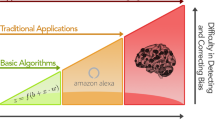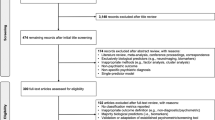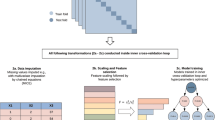Abstract
The emerging field of 'predictive analytics in mental health' has recently generated tremendous interest with the bold promise to revolutionize clinical practice in psychiatry paralleling similar developments in personalized and precision medicine. Here, we provide an overview of the key questions and challenges in the field, aiming to (1) propose general guidelines for predictive analytics projects in psychiatry, (2) provide a conceptual introduction to core aspects of predictive modeling technology, and (3) foster a broad and informed discussion involving all stakeholders including researchers, clinicians, patients, funding bodies and policymakers.
This is a preview of subscription content, access via your institution
Access options
Subscribe to this journal
Receive 12 print issues and online access
$259.00 per year
only $21.58 per issue
Buy this article
- Purchase on Springer Link
- Instant access to full article PDF
Prices may be subject to local taxes which are calculated during checkout

Similar content being viewed by others
References
Kessler RC, Aguilar-Gaxiola S, Alonso J, Chatterji S, Lee S, Ormel J et al. The global burden of mental disorders: an update from the WHO World Mental Health (WMH) surveys. Epidemiol Psichiatr Soc 2009; 18: 23–33.
Wittchen HU, Jacobi F, Rehm J, Gustavsson A, Svensson M, Jonsson B et al. The size and burden of mental disorders and other disorders of the brain in Europe 2010. Eur Neuropsychopharmacol 2011; 21: 655–679.
Gustavsson A, Svensson M, Jacobi F, Allgulander C, Alonso J, Beghi E et al. Cost of disorders of the brain in Europe 2010. Eur Neuropsychopharmacol 2012; 22: 237–238.
Insel T . Assessing the economic costs of serious mental illness. Am J Psychiatry 2008; 165: 663–665.
Stamm K, Salize H-J Volkswirtschaftliche Konsequenzen. In: Stoppe G, Bramesfeld A, Schwartz F-W (eds). Volkskrankheit Depression? Springer: Berlin Heidelberg, Germany, 2006, pp 109–120.
Dore G, Romans SE . Impact of bipolar affective disorder on family and partners. J Affect Disord 2001; 67: 147–158.
Gianfrancesco FD, Wang R-h YuE . Effects of patients with bipolar, schizophrenic, and major depressive disorders on the mental and other healthcare expenses of family members. Soc Sci Med 2005; 61: 305–311.
Guan B, Deng Y, Cohen P, Chen H . Relative impact of Axis I mental disorders on quality of life among adults in the community. J Affect Disord 2011; 131: 293–298.
Hasui C, Sakamoto S, Sugiura T, Miyata R, Fujii Y, Koshiishi F et al. Burden on family members of the mentally ill: a naturalistic study in Japan. Compr Psychiatry 2002; 43: 219–222.
Olatunji BO, Cisler JM, Tolin DF . Quality of life in the anxiety disorders: a meta-analytic review. Clin Psychol Rev 2007; 27: 572–581.
Saunders JC . Families living with severe mental illness: a literature review. Issues Ment Health Nurs 2003; 24: 175–198.
Wittmund B, Wilms HU, Mory C, Angermeyer MC . Depressive disorders in spouses of mentally ill patients. Soc Psychiatry Psychiatr Epidemiol 2002; 37: 177–182.
Bloom DE, Cafiero ET, Jané-Llopis E, Abrahams-Gesse S, Bloom LR, Fathima S et al The Global Economic Burden of Noncommunicable Diseases. Geneva: World Economic Forum. 2011, available from: http://www3.weforum.org/docs/WEF_Harvard_HE_GlobalEconomicBurdenNonCommunicableDiseases_2011.pdf.
Stephan KE, Bach DR, Fletcher PC, Flint J, Frank MJ, Friston KJ et al. Charting the landscape of priority problems in psychiatry, part 1: classification and diagnosis. Lancet Psychiatry 2016; 3: 77–83.
Darcy AM, Louie AK, Roberts LW . Machine learning and the profession of medicine. JAMA 2016; 315: 551–552.
Eyre HA, Singh AB, Reynolds C 3rd . Tech giants enter mental health. World Psychiatry 2016; 15: 21–22.
Gabrieli JD, Ghosh SS, Whitfield-Gabrieli S . Prediction as a humanitarian and pragmatic contribution from human cognitive neuroscience. Neuron 2015; 85: 11–26.
Jordan MI, Mitchell TM . Machine learning: trends, perspectives, and prospects. Science 2015; 349: 255–260.
Wolfers T, Buitelaar JK, Beckmann CF, Franke B, Marquand AF . From estimating activation locality to predicting disorder: a review of pattern recognition for neuroimaging-based psychiatric diagnostics. Neurosci Biobehav Rev 2015; 57: 328–349.
Eley TC, Hudson JL, Creswell C, Tropeano M, Lester KJ, Cooper P et al. Therapygenetics: the 5HTTLPR and response to psychological therapy. Mol Psychiatry 2012; 17: 236–237.
Hou L, Heilbronner U, Degenhardt F, Adli M, Akiyama K, Akula N et al. Genetic variants associated with response to lithium treatment in bipolar disorder: a genome-wide association study. Lancet 2016; 387: 1085–1093.
DeRubeis RJ, Siegle GJ, Hollon SD . Cognitive therapy versus medication for depression: treatment outcomes and neural mechanisms. Nat Rev Neurosci 2008; 9: 788–796.
Paulus MP . Pragmatism instead of mechanism: a call for impactful biological psychiatry. JAMA Psychiatry 2015; 72: 631–632.
Marcus G, Davis E (2014). Eight (No, Nine!) Problems With Big Data. In Sulzberger AOJ (ed). The New York Times: New York, NY, USA, p A23.
Chan MK, Gottschalk MG, Haenisch F, Tomasik J, Ruland T, Rahmoune H et al. Applications of blood-based protein biomarker strategies in the study of psychiatric disorders. Prog Neurobiol 2014; 122: 45–72.
Fu CH, Costafreda SG . Neuroimaging-based biomarkers in psychiatry: clinical opportunities of a paradigm shift. Can J Psychiatry 2013; 58: 499–508.
Hofmann-Apitius M, Ball G, Gebel S, Bagewadi S, de Bono B, Schneider R et al. Bioinformatics mining and modeling methods for the identification of disease mechanisms in neurodegenerative disorders. Int J Mol Sci 2015; 16: 29179–29206.
McMahon FJ . Prediction of treatment outcomes in psychiatry—where do we stand ? Dialogues Clin Neurosci 2014; 16: 455–464.
Savitz JB, Rauch SL, Drevets WC . Clinical application of brain imaging for the diagnosis of mood disorders: the current state of play. Mol Psychiatry 2013; 18: 528–539.
Scarr E, Millan MJ, Bahn S, Bertolino A, Turck CW, Kapur S et al. Biomarkers for psychiatry: the journey from fantasy to fact, a report of the 2013 CINP Think Tank. International Journal of Neuropsychopharmacology 2015; 18: pyv042.
Veronese E, Castellani U, Peruzzo D, Bellani M, Brambilla P . Machine learning approaches: from theory to application in schizophrenia. Comput Math Methods Med 2013; 2013: 867924.
National Research Council (US) Committee on A Framework for Developing a New Taxonomy of Disease. Toward precision medicine: building a knowledge network for biomedical research and a new taxonomy of disease. National Academies Press: Washington DC, 2011.
Mirnezami R, Nicholson J, Darzi A . Preparing for precision medicine. N Engl J Med 2012; 366: 489–491.
Lin CF, Wang SD . Fuzzy support vector machines. IEEE Trans Neural Netw 2002; 13: 464–471.
Qin ZC, Lawry J . Decision tree learning with fuzzy labels. Inform Sci 2005; 172: 91–129.
Regier DA, Narrow WE, Kuhl EA, Kupfer DJ . The conceptual development of DSM-V. Am J Psychiatry 2009; 166: 645–650.
Hastie T, Tibshirani R, Friedman J, Franklin J . The elements of statistical learning: data mining, inference and prediction. Math Intell 2005; 27: 83–85.
Ozomaro U, Wahlestedt C, Nemeroff CB . Personalized medicine in psychiatry: problems and promises. BMC Med 2013; 11: 132.
Huys QJM, Maia TV, Frank MJ . Computational psychiatry as a bridge from neuroscience to clinical applications. Nat Neurosci 2016; 19: 404–413.
Ofer D, Linial M . ProFET: feature engineering captures high-level protein functions. Bioinformatics 2015; 31: 3429–3436.
MacKay DJC . Information Theory, Inference, and Learning Algorithms. Cambridge University Press: Cambridge, UK; New York, NY, USA, 2003.
Bedi G, Carrillo F, Cecchi GA, Slezak DF, Sigman M, Mota NB et al. Automated analysis of free speech predicts psychosis onset in high-risk youths. NPJ Schizophr 2015; 1: 15030.
Hahn T, Kircher T, Straube B, Wittchen HU, Konrad C, Strohle A et al. Predicting treatment response to cognitive behavioral therapy in panic disorder with agoraphobia by integrating local neural information. JAMA Psychiatry 2015; 72: 68–74.
LeCun Y, Bengio Y, Hinton G . Deep learning. Nature 2015; 521: 436–444.
Building High-Level Features Using Large Scale Unsupervised Learning. I EEE International Conference on Proceedings of the Acoustics, Speech and Signal Processing (ICASSP): Vancouver, BC, 2013, pp 8595–8598.
Kendler KS . The nature of psychiatric disorders. World Psychiatry 2016; 15: 5–12.
Maj M . The need for a conceptual framework in psychiatry acknowledging complexity while avoiding defeatism. World Psychiatry 2016; 15: 1–2.
Hahn T, Marquand AF, Ehlis AC, Dresler T, Kittel-Schneider S, Jarczok TA et al. Integrating neurobiological markers of depression. Arch Gen Psychiatry 2011; 68: 361–368.
Bishop CM . Pattern Recognition and Machine Learning. Springer: New York, NY, USA, 2006.
Collins FS, Hudson KL, Briggs JP, Lauer MS . PCORnet: turning a dream into reality. J Am Med Inform Assn 2014; 21: 576–577.
Pine DS, Leibenluft E . Biomarkers with a mechanistic focus. JAMA Psychiatry 2015; 72: 633–634.
Pereira F, Mitchell T, Botvinick M . Machine learning classifiers and fMRI: a tutorial overview. Neuroimage 2009; 45: S199–S209.
Yang Z, Fang F, Weng X . Recent developments in multivariate pattern analysis for functional MRI. Neurosci Bull 2012; 28: 399–408.
Lueken U, Hahn T . Functional neuroimaging of psychotherapeutic processes in anxiety and depression: from mechanisms to predictions. Curr Opin Psychiatry 2016; 29: 25–31.
Lazer D, Kennedy R, King G, Vespignani A . Big data. The parable of Google Flu: traps in big data analysis. Science 2014; 343: 1203–1205.
Wolpert DH . The lack of a priori distinctions between learning algorithms. Neural Comput 1996; 8: 1341–1390.
Author information
Authors and Affiliations
Corresponding author
Ethics declarations
Competing interests
TH and SW-G declare no conflicts of interest. AAN is a consultant for the Abbott Laboratories, Alkermes, American Psychiatric Association, Appliance Computing Inc. (Mindsite), Basliea, Brain Cells, Inc., Brandeis University, Bristol Myers Squibb, Clintara, Corcept, Dey Pharmaceuticals, Dainippon Sumitomo (now Sunovion), Eli Lilly and Company, EpiQ, L.P./Mylan Inc., Forest, Genaissance, Genentech, GlaxoSmithKline, Hoffman LaRoche, Infomedic, Intra-Cellular Therapies, Lundbeck, Janssen Pharmaceutica, Jazz Pharmaceuticals, Medavante, Merck, Methylation Sciences, Naurex, NeuroRx, Novartis, Otsuka, PamLabs, Parexel, Pfizer, PGx Health, Ridge Diagnostics Shire, Schering-Plough, Somerset, Sunovion, Takeda Pharmaceuticals, Targacept, and Teva; consulted through the MGH Clinical Trials Network and Institute (CTNI) for Astra Zeneca, Brain Cells, Inc, Dianippon Sumitomo/Sepracor, Johnson and Johnson, Labopharm, Merck, Methylation Science, Novartis, PGx Health, Shire, Schering-Plough, Targacept and Takeda/Lundbeck Pharmaceuticals. He receives grant/research support from American Foundation for Suicide Prevention, AHRQ, Brain and Behavior Research Foundation, Bristol-Myers Squibb, Cederroth, Cephalon, Cyberonics, Elan, Eli Lilly, Forest, GlaxoSmithKline, Janssen Pharmaceutica, Intra-Cellular Therapies, Lichtwer Pharma, Marriott Foundation, Mylan, NIMH, PamLabs, PCORI, Pfizer Pharmaceuticals, Shire, Stanley Foundation, Takeda and Wyeth-Ayerst. Honoraria include Belvoir Publishing, University of Texas Southwestern Dallas, Brandeis University, Bristol-Myers Squibb, Hillside Hospital, American Drug Utilization Review, American Society for Clinical Psychopharmacology, Baystate Medical Center, Columbia University, CRICO, Dartmouth Medical School, Health New England, Harold Grinspoon Charitable Foundation, IMEDEX, Israel Society for Biological Psychiatry, Johns Hopkins University, MJ Consulting, New York State, Medscape, MBL Publishing, MGH Psychiatry Academy, National Association of Continuing Education, Physicians Postgraduate Press, SUNY Buffalo, University of Wisconsin, University of Pisa, University of Michigan, University of Miami, University of Wisconsin at Madison, World Congress of Brain Behavior and Emotion, APSARD, ISBD, SciMed, Slack Publishing and Wolters Klower Publishing ASCP, NCDEU, Rush Medical College, Yale University School of Medicine, NNDC, Nova Southeastern University, NAMI, Institute of Medicine, CME Institute, ISCTM. He was currently or formerly on the advisory boards of Appliance Computing, Inc., Brain Cells, Inc., Eli Lilly and Company, Genentech, Johnson and Johnson, Takeda/Lundbeck, Targacept, and InfoMedic. He owns stock options in Appliance Computing, Inc., Brain Cells, Inc, and Medavante; has copyrights to the Clinical Positive Affect Scale and the MGH Structured Clinical Interview for the Montgomery Asberg Depression Scale exclusively licensed to the MGH Clinical Trials Network and Institute (CTNI).
PowerPoint slides
Rights and permissions
About this article
Cite this article
Hahn, T., Nierenberg, A. & Whitfield-Gabrieli, S. Predictive analytics in mental health: applications, guidelines, challenges and perspectives. Mol Psychiatry 22, 37–43 (2017). https://doi.org/10.1038/mp.2016.201
Received:
Revised:
Accepted:
Published:
Issue Date:
DOI: https://doi.org/10.1038/mp.2016.201
This article is cited by
-
Mental Health in Tech: Analysis of Workplace Risk Factors and Impact of COVID-19
SN Computer Science (2023)
-
The impact of visual dysfunctions in recent-onset psychosis and clinical high-risk state for psychosis
Neuropsychopharmacology (2022)



